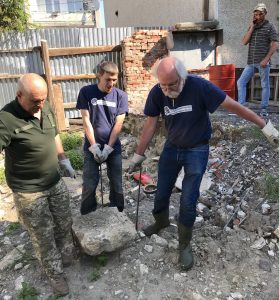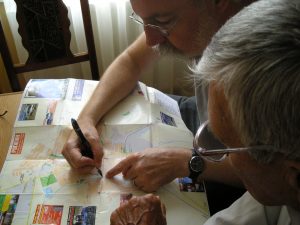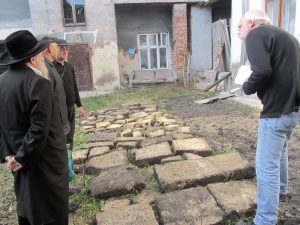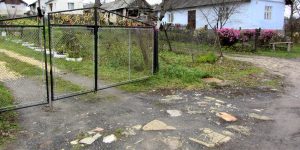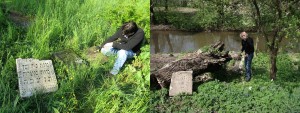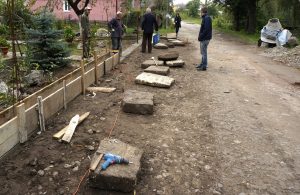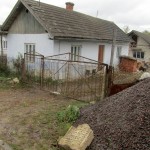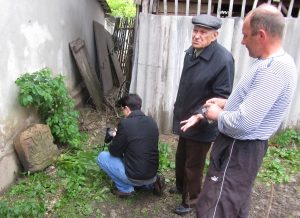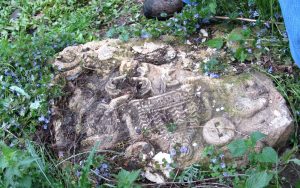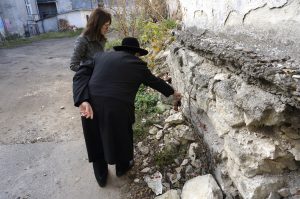![]() Ця сторінка також доступна українською.
Ця сторінка також доступна українською.
Introduction
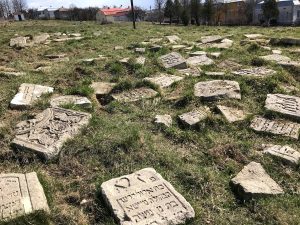
Some of the hundreds of headstone fragments returned to Rohatyn’s old Jewish cemetery. Photo © 2019 RJH.
Our heritage page on Jewish grave markers in cemeteries and elsewhere in Rohatyn highlights the current difficulty that town residents and visitors have in appreciating these important visual reminders of the past Jewish community and its many thousands of individuals: nearly all of the headstones disappeared from the cemeteries during and after World War II. The “harvesting” of Jewish headstones for building materials concurrent with the destruction of Jewish communities by German occupiers during the war, and the erasure of Jewish and Christian cemeteries by Soviet authorities after the war, was common in the region of eastern Galicia of which Rohatyn is a part.
Read about the history and heritage of Rohatyn’s Jewish headstones.
Browse our news articles for coverage of events related to this project.
Rohatyn has a rare opportunity for ongoing recovery of Jewish headstones as they are discovered in town, under streets and walkways, in old building foundations, along the riverside, beneath private gardens, and elsewhere. Continuous monitoring and response by local historians and activists and by Rohatyn Jewish Heritage have enabled the recovery of more than five hundred headstones and fragments since the beginning of the project, and their return to the Jewish cemeteries.
Jewish headstone recovery was the first heritage project initiated by Rohatyn Jewish Heritage; recovery has progressed every year since 2011. We anticipate that the project will remain active in some form for decades. The goals of the Jewish Headstone Recovery Project are to:
- recover all Jewish headstones and fragments unearthed or otherwise discovered in Rohatyn, and return them to the old Jewish cemetery for conservation, study, and display
- cooperate with the City of Rohatyn and its citizens in ongoing recovery work, when street repairs, utility trenching, and other public and private works are planned or in progress in town
- conserve and protect the recovered stones to slow their decay
- tag and document the recovered stones via photographs, descriptions, and the transcription and translation of epitaphs
- publicly post images and text from the recovered headstones to enable further historical and genealogical research and analysis, and perhaps the virtual re-assembly of fragments
As described below, progress has already been made in the recovery portion of this project. We anticipate that the project will gain expert advice toward the conservation and documentation goals thanks to a Fulbright Program research grant awarded to Rohatyn Jewish Heritage president Marla Raucher Osborn for the 2019~2020 academic year, with specific focus on the old Jewish cemetery where the headstones now lie. As for our other projects, all RJH efforts will proceed with the continuing involvement of the Rohatyn city office and the office of the Rabbi of Ivano-Frankivsk.
Headstone Recovery
First and foremost, the project is intended to rescue and recover newly-revealed matzevot and fragments, and provide them with safe haven in Rohatyn’s old Jewish cemetery. This facet of the project is significantly reactive, responding to reports either to us, or to the City office, or to our representatives in town, of any new stone discoveries. Those reports may be spontaneous, or encouraged by the churches in town and other social networks, including Facebook. The recovery rate of stones from these occasional events is impossible to predict, but experience from past years indicates that numbers of ten to more than a hundred matzevot per year are typical.
The project also includes a proactive element, to solicit reports of loose stones in disused buildings, gardens and walkways, culverts, etc. which Rohatyn residents may have seen or heard about. A less-frequent but likely greater source of recovered headstones is public works by the City of Rohatyn and by local utility companies, in which road excavations or trenching may reveal scores of stones in a single dig; our cooperation with the City sometimes enables us to plan ahead for larger recovery work and transport.
The interactive map below shows the locations in Rohatyn where headstones have been recovered since the beginning of the project, in 2011 (green), 2012 (yellow), 2013 (blue), 2014 (red), 2015 (purple), 2016 (white), 2017 (olive), 2018 (orange), 2019 (light blue), 2020 (pink), 2021 (light green), 2022 (lavender), and 2024 (chartreuse). As noted in the map description, in most cases more than one matzevah (often many) have been recovered at a single location in a single year. As the map indicates, three areas in town have been especially ‘fruitful’ in the past few years.
In the downtown area, the business and residential block bounded by vul. Ivan Franko, vul. Mickiewicz, vul. Shevchenko, and vul. Halytska, is important both historically and for the recovery project. Local historians including Mykhailo Vorobets have told us that Gestapo headquarters in Rohatyn were located on vul. Halytska of this block during the war. A private garden was the first place Mr. Vorbets led us to in April 2011, to alert us to the issue of displaced headstones; more than a dozen large and heavy fragmented headstones were unearthed there in 2012. Part of a courtyard bounded by the block yielded the largest number of matzevot in a single excavation in 2014. Headstone fragments had fallen out of the foundation of a crumbling storage building in the same courtyard from time to time. After the storage building was demolished in 2019, we recovered another four headstone fragments from the rubble. We now believe there will be many more headstones recovered from other areas at this site when conditions allow. This is a dark and special place, and we are grateful for the cooperation of the surrounding residents in allowing us to extract the matzevot.
Due east of Rohatyn’s town center, beyond the former village of Babince and about 1.5km (1 mile) from Roxolana Square on the road to Kuttsi, vul. Zelena (Green Street) has yielded matzevot almost every year, both from the street and from the creek. In 2012, as a result of sewer pipe upgrades under the street, trenching unearthed several large and significant stones (including one of a prominent historical rabbi of Rohatyn), and while walking the road to inspect and clean those, we found several others barely concealed under the road surface. More stones had been recovered by the creek here in 2011, 2012, 2014, and again in 2017. Although the original reason for laying stolen headstones along this road during and/or after World War II is not known, we believe the road likely covers many more matzevot; as utility services are extended and upgraded for the residents along the road, we will be ready to recover those.
Southwest of town center and across the Hnyla Lypa River, in the Zaluzhzhya village area, and especially on vul. Zavoda (‘across the water’) and at the banks of the river itself, Jewish headstones have turned up in several years so far. Residents of the area have told us that they suspect some of the service buildings in the neighborhood have matzevot in their foundations or floors, and as those buildings are rebuilt or renovated, more stones will surface.
Also along the river on vul. Drahomanova we have recovered many headstones in several actions over the years, including fifty large stones in a single recovery in 2016; that batch included the only completely intact matzevah yet found under the streets of Rohatyn. Another batch of 25 large stone fragments were unearthed and recovered there in 2017. It appears likely that more stones will be recovered all along the length of this street. We don’t know why so many stones have been found on both sides of the bridge here, but we guess they were used to channel the river and protect the structure during and since WWII; we have had many reports from residents alerting us to new findings in this overall area.
Elsewhere in town, several stones have been unearthed in street work for utility changes and set at the roadside or moved to a safe location by residents for our review; for example, five stones in two locations on vul. Yuri Rohatyn were a result of City-managed trenching there in 2012, and we were informed of the finds by the City office. Matzevot exhumed by a utility company before our first visit in 2011 were set beside a City parking area, waiting for someone to reclaim them – which we did.
We guess (and have heard rumors in town) that other areas are likely to yield headstones as well, as work is done in the streets and in private yards. There is an unverified rumor that vul. Danylo Halytskoho running parallel to the train tracks toward the rail station “was paved with many Jewish headstones.” Culverts crossing a small creek there are built with stones having the right size and shape, but it is not yet certain if any are matzevot. We choose not to disturb the lives of the residents there yet, just to investigate, but we are prepared to work when an opportunity arises.
Similarly, an essential part of our recovery work is repair and replacement of soil and other features of any ground or structure which is disturbed or removed during the recovery process. In leading the local work to date, Mr. Vorobets has been scrupulous in this regard, which helps immensely in our relations with the City administration and with Rohatyn residents. Although many stones have been found on or near the ground surface, or have been unearthed during other planned work, in some cases we have requested trial digs and more extensive excavation. The vegetable garden on vul. Ivan Franko (mentioned in the Introduction above) is one example: The owner had found evidence of Jewish headstones under the soil of her garden and reported that to Mr. Vorobets, but requested that any digging be postponed until the harvest season was over, and we agreed. Unfortunately, when late Autumn came, the weather was extremely wet and it wasn’t possible to dig in the garden or transport the heavy stones across the cemetery grounds. So when the weather improved, although the owner had already planted early vegetables, we struck an agreement with her to excavate and then replace the lost soil and seeds.

The excavation in the garden on vul. Ivan Franko: original state, April 2011; digging, winter 2012 (two views); restoring soil, winter 2012; the stack of headstones on the sidewalk, winter 2012; the replanted garden, spring 2012. Photos © 2011, 2012 RJH and Abram Lyons.
Initially we had designated the Rohatyn new Jewish cemetery to receive all of the recovered headstones, and we transported many pieces there following the example of those who preceded us. However, an assessment of more than 100 recovered stones in Rohatyn in late 2014 by Rabbi Kolesnik of Ivano-Frankivsk led him to conclude that all had originally stood in the old Jewish cemetery. So on his recommendation, a decision was made to return all future recovered stones to the old cemetery, and to move the earlier stones there as well (see the Old Jewish Cemetery Rehabilitation Project). That move was made in early 2015.
Cooperation with the City of Rohatyn and Its Citizens
Officials of the City of Rohatyn have been supporters of this project since its beginning; we have had good relations and cooperation in this effort from both the past administration as well as the current mayor and his staff. Archpriest Dmytro Bihun of the Ukrainian Greek Catholic church on Rohatyn’s main square spoke with us and then made a call to his parishioners to bring loose headstones in town to our attention. Rohatyn-based journalists and teachers have alerted us to stones unearthed during construction work in town. Homeowners have passed word to us when stones appear in their gardens or in walkways. And a number of discovered fragments have been quietly set to the side of roads and the river where they can be retrieved, and even returned to the old cemetery and placed where we would easily find them. Facebook now plays a larger role in communication, with residents alerting us to new headstone discoveries in town.
Throughout all the years of this project, and beginning decades before we started, retired teacher and local historian Mykhailo Vorobets has been tracking the location of displaced headstones, arranging for their release and recovery, managing payment of funds donated through RJH (and earlier, through ghetto survivors) to laborers for digging out and transporting the stones, and speaking to his fellow citizens about the moral importance of this work; without question, his prominence in Rohatyn and his righteous actions have made this project not only possible but also successful. Now that his advanced age requires him to give up his leadership on this project, Rohatyn Jewish Heritage has assumed his role, but Mr. Vorobets continues to speak to townspeople, students, and the city administration about the need to remain alert to opportunities for further stone recoveries. It is with respect and honor that we carry his efforts forward.
Conservation of Headstone Materials
This project includes research into and application of stone conservation methods and materials, a goal which will be advanced as a component of the 2019~2020 Fulbright project Marla will lead in support of the Old Jewish Cemetery Rehabilitation Project. We will make use of a variety of resources and experts in this task; see the References page for links to specialist organizations in Europe and North America, and for reference books and papers on the topic.
The matzevot in Rohatyn deserve this care; each of them is an heirloom, and they have important stories to tell. During recovery actions and while working around the recovered stones in the old cemetery, we encounter stones of great beauty and importance. In 2012, while working on vul. Zelena, we found several large stones which had been unearthed by sewer work under the road. Although caked with mud, the image of a lion and some writing was visible. As washing and scrubbing continued in the evening, the full design became clearer, revealing a second lion, a crown, and more script. Returning the next morning, translation of the text revealed that the stone belonged to a prominent rabbi in Rohatyn. The stone was transported to the cemetery; soon after, a Hasidic group returned this stone to its proper place in an ohel they had built over three graves of rabbis in the old Jewish cemetery just a year earlier, as the first reconnected stone since the war.

The rabbi’s matzevah on vul. Zelena: discovery; cleaning; Jeremy Borovitz translates; return to the cemetery. Photos © 2012, 2014 RJH.
We realize that ongoing decay and disintegration of the surviving headstones is inevitable, and that at best it can be slowed. The stone materials from which nearly all the recovered matzevot are made are very soft; these stones would also have decayed had they stood in the cemeteries for the past 70 years. So it is imperative that we record what we can about these survivors before they fade.
Documentation of the Matzevot and Fragments
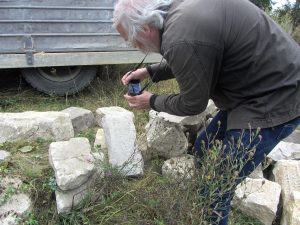
Photographing newly-recovered headstone fragments as they are unloaded at the cemetery. Photo © 2015 RJH.
Identification of individual fragments is complicated because they are not fixed in a single location; most have been moved at least twice since recovery and are certain to be moved at least once more. Thus a reliable scheme for permanently tagging the stones is needed; we have concepts for methods and materials but will wait to begin work until those and other ideas are evaluated as part of the 2019~2020 Fulbright project focused on the old Jewish cemetery.
Once the stones are tagged, we can associate photographs and data about the dimensions, materials, colors, features, symbols, styles, etc. of the fragments. It is clear that we need images of all sides of each stone, to do more than catalog and transcribe them. We need a way to reunite fragments of stones, like three-dimensional puzzles, using their features, shapes, sizes, and materials, and we need technology to help us bring the parts together.
In past years, Rohatyn Jewish Heritage plus Dr. Alex Feller of the Rohatyn District Research Group (RDRG) and our long-time supporter Alex Denysenko have worked to record camera images of the stones and to post them on websites for review, transcription, and translation. These initial efforts have helped to preserve images of the fragile stones as they resurfaced, and to begin connecting the fragments with descendants of Rohatyn Jewish families. The online image collection of recovered stones is incomplete (only about half of the recorded images have been posted publicly), but overall most of the stones have an initial record on which to build. This goal of the headstone recovery project shares the task of creating an online database of headstone fragments with the Digital Information Project.
See images and translations of many of the headstones and their epitaphs.
Maintenance
Recurring maintenance of the site and its features is an important part of all of our projects; planning and cost estimates for long-term care and maintenance of the matzevot and their supporting structures will follow the 2019-2020 Fulbright project research and development, and low-maintenance considerations will serve as essential factors in many conservation decisions. In the meantime, maintenance is limited to basic cleaning of the stones and clearing of the old Jewish cemetery grounds around the recovered stones.
Project Costs
This project has been long-running but at very low annual cost; as described above, the labor costs to recover stones and the material costs to make whole the spaces from which stones have been excavated have been been reasonable and appropriate for the region.
Individual donations to Rohatyn Jewish Heritage have funded the expenses of this project, informally from 2011 and then with the generous assistance of Gesher Galicia to process online donations for us since 2013. Total expenses for labor and materials from 2011 through 2018 were 13,365UAH; exchange rates varied through this time, but at a nominal exchange rate of 25UAH/US$, the expenses for the first eight years of the project were roughly US$535.
Two important and potentially costly aspects of the project have not yet been funded. With the retirement of Mykhailo Vorobets from local management of laborers to unearth and transport recovered headstone fragments, RJH and our volunteers have taken on this responsibility using social media and our own hands, but there is still a need for local oversight and communication, and to manage larger recovery actions; if we are not able to identify and engage another local volunteer to manage this work (from City staff or long-term residents), we anticipate we will need to hire a manager on annual contract.
We have also not yet allocated funds to support digging by the City or private property owners to unearth stones, or the demolition of unused buildings to recover stones from foundations. To date, all recovery actions have been reactive, i.e. in response to roadwork or construction initiated by others. When the old Jewish cemetery in Rohatyn has been prepared to receive larger numbers of recovered headstones, we anticipate making a few exploratory digs at locations which we and Mr. Vorobets believe still cover numerous stones, and then negotiating with the City and/or property owners to excavate and resurface those areas.

